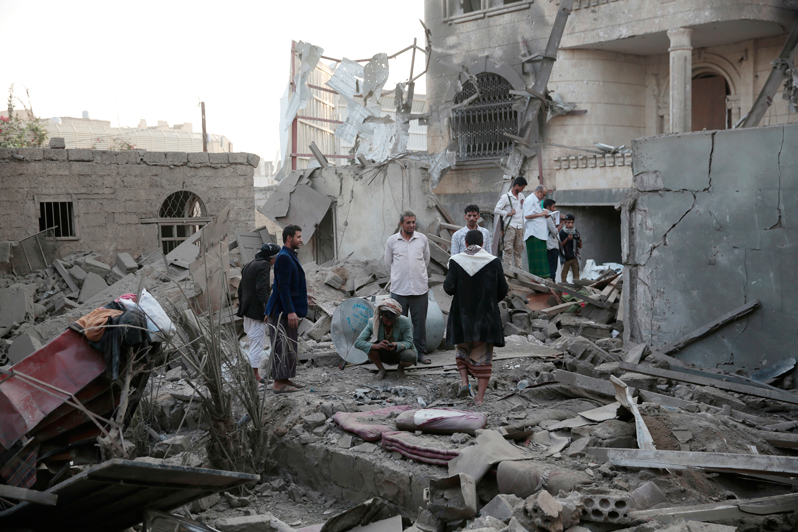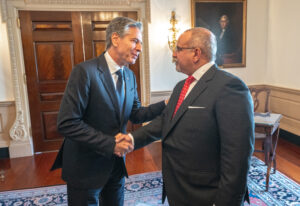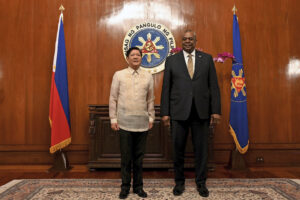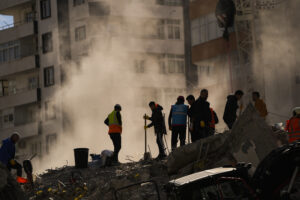The United States and the Crucifixion of Yemen
We are fueling an epic humanitarian crisis in the impoverished Arab country. People inspect houses destroyed by Saudi-led airstrikes in Sanaa, Yemen. (Hani Mohammed / AP)
People inspect houses destroyed by Saudi-led airstrikes in Sanaa, Yemen. (Hani Mohammed / AP)
The United States has killed, maimed, displaced and otherwise harmed an astonishing number of people in its 241-year record of murder and mayhem—including more than 20 million killed in 37 nations since 1945.
Murder, Direct and Proxy
Direct
A grisly distinction exists between those Uncle Sam has directly assaulted and those he has more indirectly attacked. Here are just a few examples from the long record of direct U.S.-military mass murder since 1945:
● Hiroshima (146,000 killed with a single bomb—what President Harry Truman called “the greatest thing in history”) and Nagasaki (80,000): The arch-criminal atom bombings were unnecessary and savagely carried out even though the U.S. high command knew Japan was defeated and ready to accept U.S. surrender terms.
● Iran Air Flight 655: On July 3, 1988, the USS Vincennes crossed into Iranian waters and shot down an Iranian civilian plane, blowing 290 people out of the sky. The Vincennes’ commander was granted an award for “exceptionally meritorious conduct.”
● The “Highway of Death”: U.S. fighter jets engaged in a frenzied slaughter of tens of thousands of surrendered Iraqi troops in 1991. Lebanese-American journalist Joyce Chediac testified that “U.S. forces continued to drop bombs on the convoys until all humans were killed. So many jets swarmed over the inland road that it created an aerial traffic jam, and combat air controllers feared midair collisions.”
● Fallujah: The U.S. Marines waged chemical warfare and used radioactive ordnance in the process of leveling a great Iraqi city in April and November of 2004.
● The U.S. drone war program (2001 to present), aptly described by Noam Chomsky as “the most extreme terrorist campaign of modern times”: The Bureau of Investigative Journalism reports a minimum number of 3,734 U.S. drone strikes with nearly 10,000 killed, including 1,427 civilians in Afghanistan, Pakistan, Somalia and Yemen, “since the Bureau began collecting data.”
Indirect
Dreadful as such incidents of direct imperial butchery are, the United States may well have killed, maimed and displaced more people indirectly, through proxies and clients.
In 1954, a CIA-orchestrated coup removed the democratically elected and leftist Guatemalan government of Jacobo Árbenz. Over the next four decades, U.S,-backed right-wing Guatemalan regimes killed tens of thousands of peasants, workers, students and activists.
In 1960, the CIA killed Congo’s first independent head of state, the leftist anti-colonialist leader Patrice Lumumba. The United States subsequently backed the brutal Congolese dictator Joseph Mobuto, who killed hundreds of thousands of people. The U.S. has been significantly responsible for as many as 3 million deaths in that resource-rich country ever since. It sponsors and protects the Rwandan dictator Paul Kagame, whose body count in his own country and Congo runs into the tens of thousands.
In 1965 and 1966, the United States worked with Britain and Australia to help orchestrate the overthrow of the democratically elected leftist government of Indonesia and the subsequent massacre of somewhere between 500,000 and 1 million Indonesian peasants, workers, intellectuals and activists. Coup General Suharto received military and economic assistance from the U.S. over three decades of subsequent authoritarian rule.
In December 1975, Suharto got a green light from his sponsors in Washington to invade East Timor. The Indonesian military received advanced weaponry from the United States and the U.S. client Israel as it brutally annexed the poor island nation and killed at least 180,000 of its inhabitants.
In 1973, a CIA-engineered coup overthrew the democratically elected socialist government of Chilean President Salvador Allende and replaced him with the fascist butcher and close U.S. ally, General Augusto Pinochet. Pinochet’s regime killed 30,000 workers, students, peasants, intellectuals and activists while introducing U.S.-imported economic policies from the University of Chicago during the 1970s and 1980s.
A U.S.-sponsored and -equipped fascist regime in Argentina and allied death squads killed as many 30,000 workers, students, intellectuals and activists in that country between 1974 and 1983.
In the late 1970s and 1980s, Washington, Saudi Arabia and Pakistan created the extremist Islamo-Wahhabist forces that became al-Qaida and the Taliban as part of the U.S. Cold War with the Soviet Union in order to destabilize a pro-Soviet regime in Afghanistan. These Sunni jihadist forces have killed hundreds of thousands of people in Southwest Asia and the Middle East ever since.
U.S.-sponsored authoritarian regimes in Central America killed more than 300,000 people during Ronald Reagan’s two terms. Lavish funding, training and equipment from Washington fueled this epic bloodshed. Victims were murdered and maimed as punishment for—and warnings against—participation in popular struggles to redistribute land and improve working and social conditions for peasants and workers in Guatemala, El Salvador and Honduras.
Tens of thousands of Iranians were executed, with U.S. economic, political and military assistance and sponsorship, by the Iranian dictator Shah Mohammad Reza Pahlavi, who was installed into power after a CIA-engineered coup overthrew Iran’s democratically elected leftist government in 1953.
Between 1980 and 1988, the U.S. backed Iraq in an epic war with Iran. This horrific conflict produced at least 1 million Iranian casualties, including 300,000 soldiers killed and untold thousands still suffering from Iraqi chemical weapons developed with U.S. assistance.
Saudi Arabia, the most reactionary government on earth, has slaughtered tens of thousands of dissenters and ethnic (Shiite Muslim) minorities with U.S. arms, economic assistance and diplomatic cover. It is home to the extreme Sunni-Wahhabist ideology that has fueled mass-murderous jihadists affiliated with al-Qaida and Islamic State, which have received lavish funding from Saudi Arabia. The Saudi kingdom is a prized U.S. ally. It has been visited by both Barack Obama and President Trump in recent years. Trump went to Riyadh in May to seal a $110 billion arms deal with the Saudis.
(For a longer list of post-1945 global mass killing operations carried out by the U.S. military, see my slightly larger compilation here. Also see William Blum’s “Rogue State: A Guide to the World’s Only Superpower” and Ward Churchill’s “On the Justice of Roosting Chickens: Reflections on the Consequences of U.S. Arrogance and Criminality.”)
‘An Absolute Shame on Humanity’
Which brings us back to Yemen, a developing humanitarian catastrophe in one of the poorest nations on the planet. Yemen is an Arab country at the southern end of the Arabian Peninsula. It is bordered by the Gulf of Aden (leading to the Indian Ocean) on its south, the Red Sea and Africa to its west, Oman to its east and the powerful, oil-rich and U.S.-equipped Saudi regime along its long northern border. It has been torn by a “civil war” that began in March 2015, when Saudi-led forces launched a military campaign backing the nation’s Sunni Muslim-embattled government against allied Shiite Muslim Houthi rebels.
More than 10,000 Yemini civilians have died and more than 44,000 have been injured in this conflict. Most have been killed and maimed by more than two years of airstrikes conducted by a regional coalition headed by the U.S.-equipped Saudi Arabian regime.
More bombing-related deaths will likely result in indirect fashion. The Saudi-led bombing campaign has devastated much of Yemen’s basic infrastructure, putting 7 million Yemenis at risk of famine. Cholera, a prominent 19th century disease, has become epidemic there, thanks to the collapse of water sanitation. Cholera has already killed nearly 2,000 Yemeni civilians, and 300,000 Yemenis are currently infected. According to the International Red Cross, more than 600,000 Yemenis could contract cholera before the end of the year.
Sixty percent of the country is food-insecure, and more than half the population lacks access to safe drinking water. A child dies from preventable causes on the average of once every 10 minutes in Yemen.
Wolfgang Jamann, CEO of the human rights organization CARE, recently took a five-day trip to Yemen. “The current situation is an absolute shame on humanity,” he told reporters.
Direct U.S. Assault
Yemen has been a significant target of direct U.S. military attack in America’s terrorist “global war on terror.” It was home to the first known U.S. drone attack outside Afghanistan in 2002. Hundreds of U.S. drone and other airstrikes have targeted Yemen since 2009, including 70 drone strikes between Feb. 28 and April 2—an astonishing outburst in “the most extreme terrorist campaign of modern times.”
Trump drew his first military blood in Yemen. U.S. Navy special forces carried out a raid—planned by the Obama administration and handed off to the incoming Trump team—that killed 25 civilians, including 10 children in the mountainous Yakla region of Yemen’s Al Bayda province. One of the children killed was an 8-year-old girl, Nawar al-Awlaki, daughter of the Islamist preacher Anwar al-Awlaki, who was killed on Obama’s orders in a September 2011 U.S. drone strike in Yemen. Nawar’s older brother, 16-year-old Abdulrahman, was killed in a second Obama-commanded drone strike soon afterward.
Trump’s continuation of the U.S. slaughter of al-Awlaki’s children was consistent with his campaign claim that he would kill the relatives of terrorist suspects—a war crime. “The other thing with the terrorists is you have to take out their families; when you get these terrorists, you have to take out their families,” Trump pronounced on Fox News in December 2015.
A Proxy War
Mainly, though, it’s been a case of indirect U.S. assault. As Jesse Mechanic noted on Huffington Post in February, “For the almost two years since the war began, the U.S. has been a vital ally to Saudi forces. Like many of our conflicts over the decades, it’s mostly a proxy war we’re fighting here. Most of our influence in this conflict isn’t direct exactly, but we are certainly a party to this destruction.” The U.S. supplies surveillance, targeting and other intelligence data to the Saudis. It refuels Saudi planes and sells the Saudis weapons, including more than $20 billion worth of arms in 2016 alone. The ordnance sold includes cluster bombs, which are banned by 119 countries because they are wildly inaccurate and kill and maim civilians for years after military conflicts end.
America’s direct attacks on Yemen since 2002 have technically targeted al-Qaida and affiliated jihadists. Under Trump, however, there has been a significant increase in the number of direct U.S. attacks and indications of a shift toward more direct and explicit support for the Saudi-backed, Sunni Yemen government’s war on the Houthi rebels and their rival government. As Reuters reported in late March:
The United States is considering deepening its role in Yemen’s conflict by more directly aiding its Gulf allies battling Iran-aligned Houthi rebels, officials say, potentially relaxing a U.S. policy that limited American support. … Trump’s predecessor, Barack Obama, increasingly sought to limit U.S. ties to the civil war in Yemen and his administration became unnerved by civilian casualties caused by the Saudi-led coalition, which have come under intense international scrutiny.
The Trump White House has been far less squeamish about directly generating Yemeni casualties and about explicitly aiding the Saudis and their Persian Gulf allies in the fight against the allegedly Iran-affiliated Houthis.
‘Say No to American Terrorism’
A recent short PBS “Frontline” report from Yemen was filmed in May. It shows doctors and nurses working without pay (the government has no money to give) to save the lives of emaciated children plagued by malnutrition and cholera. It shows infants near death from hunger and dehydration and teenagers in wheelchairs as a result of Saudi-U.S. bombs.
“I don’t get salary,” one nurse tells “Frontline” producer Martin Smith. She explained that “I may be sick one day soon and will depend on others to save my life without salary.”
The nurse told Smith that she “blame[s] this nation and the foreign powers who are attacking this nation. They are attacking the weak.” As usual, noncombatants suffer the most.
In the beginning of the “Frontline” report—a prelude to a longer “Frontline” documentary scheduled for next year—Smith blames “two-plus years of airstrikes by the Saudi-led coalition, the region’s wealthiest country [Saudi Arabia] bombing the region’s poorest country [Yemen].”
Smith notes that the Saudis rationalize their bombing of the weak by claiming the rebel Shiite-Muslim Houthi forces and Houthi government in the Yemeni capital of Sanaa are agents of Riyadh’s regional archrival, Shiite Iran. But, Smith notes, a visitor to the nation finds little sign of Iranian influence in a landscape devastated primarily by Saudi bombs and missiles.
“Frontline” implicates the United States in the heartbreaking human disaster unfolding in Yemen. “Americans may not be aware of American involvement in the war in Yemen,” Smith says, “but Yemenis in Sanaa and in northern Yemen know where the weapons are coming from.”
Smith and his film crew attended a big “Say No to American Terrorism” rally protesting Trump’s recent visit to Riyadh.
Smith reports that he and his American crew met “absolutely no hostility” in Yemen. “There was only a sense,” he says, “that our government was to blame and ordinary Yemenis want the world to be aware of what’s going on.”
“We respect the United States of America … in our hearts,” one Yemeni protester told Smith, “but we came here to express our outrage against United States policy.”
Some Recommendations
Hopefully, “Frontline” will go deeper in its forthcoming extended documentary. If it is serious about fleshing out the full U.S. role in the crucifixion of Yemen (skepticism is warranted when one peruses the names of the power elite foundations—Ford, MacArthur, Park, John and Helen Glessner and Henry Luce—listed at the end of its report), then it will do at least six things.
First, it will mention that the U.S. funding of the Saudi war machine goes back many decades and that the “liberal” Obama White House offered little resistance to the Saudis’ deadly assault on Yemen—launching numerous direct U.S. airstrikes into the country and signing off on huge arms packages with Riyadh. It will not blame the central role of the U.S. in the crucifixion of Yemen just on the Trump administration.
Second, it will observe that the U.S. has an earlier, Cold War-era history of deadly, indirect intervention in Yemen, including CIA sponsorship of paramilitaries who deployed in south Yemen, falsely designated as a “Soviet-run international terrorist network” under Ronald Reagan.
Third, “Frontline” should investigate Riyadh’s U.S-backed claim that Yemen’s Houthi rebels are agents of Iranian aggression and regional expansion—a charge for which little evidence exists. For its part, Iran rejects accusations that it is giving financial and military support to the Houthis in the struggle for Yemen and blames the deepening crisis on Riyadh.
Fourth, “Frontline” should tie U.S. support for the Saudis’ war crimes in Yemen to Washington’s long-standing special petro-imperial relationship with the arch-reactionary but oil-rich Saudi kingdom. As Jesse Mechanic explained in February, “Relations between the U.S. and Saudi Arabia became strained following the Iran nuclear deal, and [Washington] relies on their intelligence and assistance. … [U.S.] support is more of an attempt to repair an important relationship than it is a show of overwhelming support for the Saudi cause.” Washington is turning a blind eye to one of its client state’s crimes in the case of Saudi Arabia’s war on Yemen largely because it is concerned about keeping oil-rich Saudi Arabia in the United States’ geopolitical pocket in the wake of Obama’s nuclear deal with Tehran—a diplomatic triumph (driven by Washington’s need for Iranian support in the war against the Islamic State) that Riyadh has never accepted.
Fifth, Frontline also should connect the Yemen story to Washington’s related special hostility to Iran, which the U.S. imperial establishment has never forgiven for breaking out from its own prior subordinate client-patron relationship with the U.S. in 1979.
Sixth, it will connect Saudi Arabia’s war on the Houthis to its fear of Shiite rebellion within its own borders. When Saddam Hussein was overthrown after the 2003 U.S. invasion, the chaos that ensued in Iraq “raised the specter of a [Shiite] alliance across majority [Shiite] Iraq. Especially threatening” to Washington, Lehigh University political scientist Anthony DiMaggio recently wrote me, has been “the prospect of such an alliance including … [Shiites] in Saudi Arabia, who live under oppressive conditions mainly in the east, the oil-rich region of the country.”
I do not share other world citizens’ willingness to pardon ordinary Americans from responsibility for U.S. government crimes, both direct and indirect, around the world and in Yemen. The real story of what the U.S. is doing globally is readily available for those willing to look beyond “mainstream” sources and doctrine. Most Americans remain willfully ignorant of terrible transgressions regularly committed in their name by Uncle Sam and his allies and clients abroad.
This ugly indifference extends even to many on the nominal left, including Bernie Sanders fans who gave unconditional support to Sanders even after he told a peace activist in Iowa City in 2015 that the Saudis “are going to have to get their hands dirty” in the U.S-led “war on [of] terror.”
“For Bernie and his supporters,” 2016 Green Party vice presidential candidate Ajamu Baraka wrote two years ago in an essay titled “The Yemen Tragedy and the Crisis of the American Left,” “the mischief that the Saudi government and private individuals have been engaged in across the region financing groups like [Islamic State] wasn’t dirty enough.”
Neither, apparently, was Riyadh’s U.S.-equipped campaign to bomb Yemen back to the 19th century—a campaign that has turned Yemen into a shameful humanitarian disaster of epic proportions.
Your support is crucial…With an uncertain future and a new administration casting doubt on press freedoms, the danger is clear: The truth is at risk.
Now is the time to give. Your tax-deductible support allows us to dig deeper, delivering fearless investigative reporting and analysis that exposes what’s really happening — without compromise.
Stand with our courageous journalists. Donate today to protect a free press, uphold democracy and unearth untold stories.






You need to be a supporter to comment.
There are currently no responses to this article.
Be the first to respond.